
Curfew Capture 1. Soldier Fly (Stratiomyidae)
On 24 March 2020, the Government of India ordered a nationwide lockdown for 21 days, limiting movement of the entire population of India as a preventive measure against the COVID-19 pandemic in India. It was ordered after a 14-hour voluntary public curfew on 22 March, followed by enforcement of a series of regulations in the country’s COVID-19 affected regions.
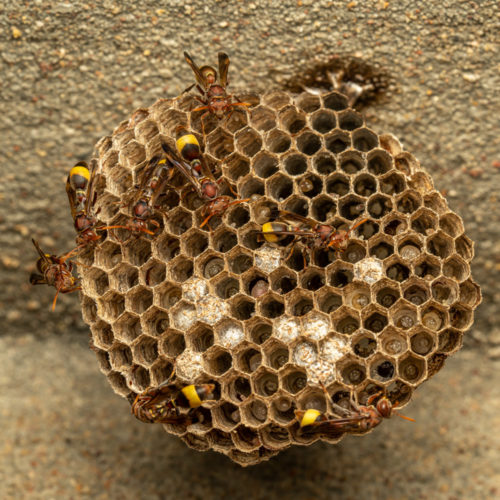
Curfew Capture 2. Ropalidia
Ropalidia social wasp nest. even they are under house quarantine 🙂
Since I had to limit my hospital practice due to lock down, I planned macro photography capture in my backyard garden plan right from 22nd March. Rules were simple, every day I would shoot between 4:30 PM to 6:00 PM using my Sony Alpha A7R IV, body & Sony FE 90mm f/2.8 Macro G OSS Lens along with Godox Ving V860S II E-TTL Li-ion Camera Flash. Speed lights are incredibly useful for macro photography, they’re light does not always look flattering. Harsh shadows in unwanted places, blown-out highlights and strong aberrations are common issues. Diffused light looks more natural and generally more pleasing to the eye too. That is where the diffuser comes into place. As a flash diffuser, I used Beetle diffuser from Varun HB. For macro photography flash diffusers are essential.

Curfew Capture 3. Stink bug
A Stink bug Camouflaged on Indian Almond Tree
I have tried many diffusers and have created several such diffusers myself. If you are not a fan of Do it yourself trend, please do have Beetle softbox which I highly recommend. Super-soft light and its practicality make this sort of diffuser the ideal solution in the field. Beetle softbox will always be right where you need them; at the front of your lens.

The total number of species I captured during 21 days of the first lockdown are 86 species. I have published here around 50 of them as that was my goal to capture 50 species over 21 days of lockdown.

Curfew Capture 4. Anodendron paniculatum
Anodendron paniculatum seed, a perfect example of wind dispersal, caught mid-air.

Curfew Capture 5. Tiny Grass Blue (Zizula hylax)
Tiny Grass Blue (Zizula hylax) – Second smallest Butterfly in India. There are only one species of butterfly known to be smaller than this, and that is Grass Jewel or Freyeria trochylus.

Curfew Capture 6. Mordellidae – tumbling flower beetles
The Mordellidae is a family of beetles commonly known as tumbling flower beetles for the typical irregular movements they make when escaping predators, or as pintail beetles due to their abdominal tip which aids them in performing these tumbling movements. The apparently tumbling movements are composed of a series of very rapid separate jumps (each jump of a duration of approximately 80 ms). They result from the beetle’s efforts to get itself back into take-off position for the flight when it has been in either lateral or dorsal position. Each individual jump should be considered as an extended rotation, performed by one leg of the third leg pair. Worldwide, there are about 1500 species.

Curfew Capture 7. A string of pearls of Hibiscus anther 😉

Curfew Capture 8. Asemonea cf. tenuipes
Asemonea cf. tenuipesalso known as Tailed Spider. You can read more about in my blog – https://drkrishi.co.in/asemonea-spider/

Curfew Capture 9. Jewel Bug – Chrysocoris purpureus
Chrysocoris purpureus (Family Scutelleridae) A true bug from order Hemiptera (sometimes referred to as Jewel Beetle, wrongly).

Curfew Capture 10. Stink Bug
Stink Bugbelonging to family Pentatomidae, order Hemiptera.

Curfew Capture 11. Culex mosquito
Blood Donation to a female Culex mosquito

Curfew Capture 12. Hoplasoma Beetle
Beetle belonging to genus Hoplasoma, Subfamily Galerucinae, family Chrysomelidae.

Curfew Capture 13. Clatomorpha hastata, leaf-footed bug
Coreidae is a large family of predominantly sap-suckling insects in the Hemipteran suborder Heteroptera.

Curfew Capture 14. Ladybug larva.
Ladybugs are beetles belong to the family Coccinellidae. Known by several other names: lady beetles, ladybug beetles, and ladybird beetles. All ladybugs progress through a four-stage life cycle known as complete metamorphosis. Ladybug larvae look somewhat like tiny alligators, with elongated bodies and bumpy exoskeletons. They feed voraciously. In the two weeks it takes to become fully grown, a single larva can consume 350 to 400 aphids.

Curfew Capture 15. Polyrhachis ant.
Polyrhachis do not have a stinger but an acidipore that can spray formic acid. When attacking, this is often sprayed in combination with biting thus making the acid more effective against the subject of the attack.
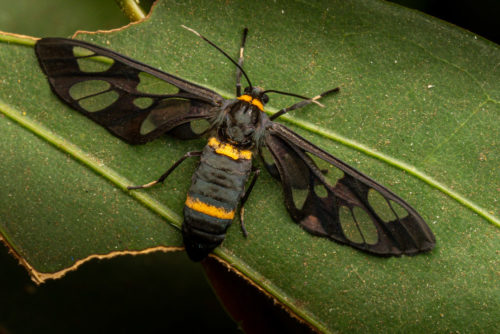
Curfew Capture 16. Syntomoides imaon, the handmaiden moth
Syntomoides imaon, the handmaiden moth, is a moth of subfamily Arctiinae, subtribe Ctenuchina.

Curfew Capture 17. Tephritid fruit fly sometimes called peacock flies. (Tephritidae, Trypetidae)
Some of these fruit flies have extensive mating rituals or territorial displays. Many are brightly coloured and visually showy. Some fruit flies show Batesian mimicry, bearing the colours and markings of dangerous arthropods such as wasps or jumping spiders because it helps the fruit flies avoid predation, though the flies lack stingers.

Curfew Capture 18. Male Mosquito.
Male mosquitoes have more flagella or fine hairs on their antennae, so many so that it appears noticeably bushy to the naked eye. These flagella are important to a male mosquito’s hearing, which comes in handy when the male is looking for female mosquitoes—his primary interest. Only female mosquitoes make that annoying buzzing sound. Male mosquitoes are generally smaller than female mosquitoes. Because male mosquitoes have no need for human blood, they will typically avoid human contact.

Curfew Capture 19. Epeus jumping spider.
They are very active spiders occurring usually on bushy hedges, shrubs and on tall trees. For details check my blog – Epeus-spider

Curfew Capture 20. Diacamma indicus worker ant.
Diacamma colonies are queenless, with reproduction instead being performed by a single mated gamergate worker. The control of reproduction in Diacamma is unique among ants. All Diacamma workers eclose with a pair of novel thoracic appendages called gemmae.
The presence of intact gemmae causes a worker to become sexually receptive and ultimately a gamergate. Loss of the gemmae, however, causes an individual to become a normal worker. The acting gamergate in a colony, therefore, mutilates the gemmae of newly eclosed workers and thereby maintains its reproductive dominance.
The gemmae are filled with secretory cells which open to the surface and play a definite role in determining the fertility of Diacamma workers. The mutilation of gemmae in young workers of Diacamma sp. caused their bursa copulatrices and spermathecae to degenerate, leaving them incapable of mating.

Curfew Capture 21. Camponotus parius
Camponotus pariusis one of the more common carpenter ants we see in our gardens. Unlike many of the larger Camponotus species which are generally nocturnal, this ant, itself large and conspicuous, forages throughout the day. Here you can see the ant is feeding on the mealy bugs, scale insects which have affected hibiscus plant.

Curfew Capture 22. Amata bicincta
Amata bicincta is a moth in the genus Amata of the subfamily Arctiinae. It is also known as the nine-spotted moth and handmaiden moth. It is a common day-flying warningly coloured moth. The adult is unpalatable to birds and other predators. A similar moth with which this is confused is Syntomoides imaon which I posted above as Curfew Capture 16.

Curfew Capture 23. Crane Flies
Limonia (Euglochina) sp. of Crane flies. Order Diptera, Family Tipulidae. An adult crane fly, resembling an oversized mosquito, typically has a slender body and stilt-like legs.

Curfew Capture 24. Ant-like beetles.
The Anthicidae is a family of beetles that resemble ants. Adult beetles are omnivorous, being known to consume small arthropods, pollen, fungi, and whatever else they can find. Some species are of interest as biological control agents, as they can eat the eggs or larvae of pests. Larvae are either omnivorous, predators, or fungus-eaters.
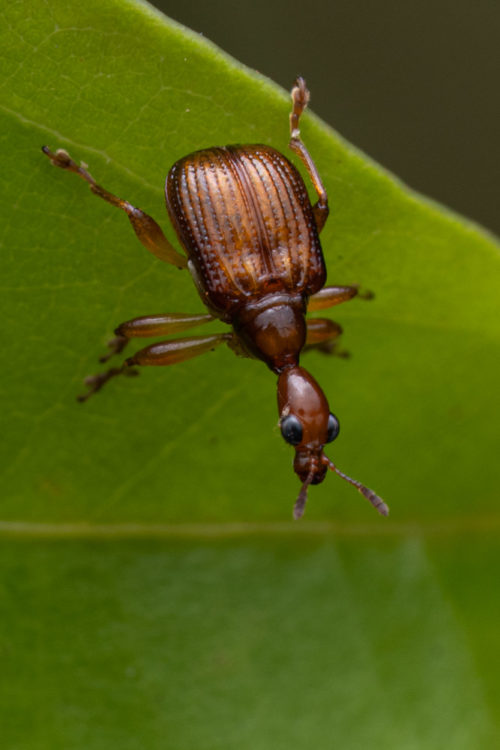
Curfew Capture 25. Juvenile leaf-rolling weevil
Juvenile leaf-rolling weevil belonging to Apoderus species. Apoderus beetles are commonly called leaf-rolling weevils. They are not really weevils, but are beetle species belonging to the family Attelabidae and subfamily Attelaninae. Because of the trunk-like elongated head, they are often mistakenly attributed to the giraffe weevils.

Curfew Capture 26. Gotra species, Family Ichneumonidae.
Also called Banded Pupa Parasite Wasps. Gotra is a very large genus. The wasp has a white band on the antenna. Its body is black with white dots on the thorax and white-banded abdomen. The legs are orange-brown in colours. The ovipositor is medium in length. They are usually found searching for host cocoons on the bark of trees.

Curfew Capture 27. Dilobocondyla bangalorica
Dilobocondyla bangaloricais a species of ant in the subfamily Myrmicinae. This arboreal ant nests in deadwood and crevices in tree barks. The species name is after the type locality, Bangalore, where the ant was discovered in 2006. The ants build their nest in the Frangipani plant species Plumeria alba and Plumeria rubra. While they live in colonies like other ants, they forage individually on tree trunks. The spines on the head and thorax are blunt, thus differentiating this species from others.

Curfew Capture 28. Big-eyed bugs
Big-eyed bugs belonging to family Geocoridae. Commonly known as big-eyed bugs, the species in Geocorids are beneficial predators but are often confused with the true chinch bug, which is a pest. Big-eyed bugs are considered an important predator in many agricultural systems and feed on mites, insect eggs, and small insects such as pink bollworm, cabbage loopers, and whiteflies.

Curfew Capture 29. Hersilia
Hersilia species is commonly called Two-tailed spider. Distributed throughout India, Myanmar, Philippines, Sri Lanka. Very long Posterior lateral spinnerets, much longer than the abdomen, give them the name, Two-tailed spider.
It lives on tree trunks, often spotted on trunks of coconut palms in a head-down position. It feeds on moths, ants and other smaller spiders. Cocoon is generally laid in the crevices of trees. It runs around the tree when disturbed. It is a very common spider in our tree barks and exhibits colour variation according to the substrate on which it is found.

Curfew Capture 30. Ensign Fly, Family Sepsidae.
The Sepsidae are a family of flies, commonly called the black scavenger flies or ensign flies. Over 300 species are described worldwide. They are usually found around dung or decaying plant and animal material. Many species resemble ants, having a “waist” and glossy black body. Many Sepsidae have a curious wing-waving habit made more apparent by dark patches at the wing end.
Many species have been spread over large territories in association with livestock. Adult flies are found mostly on mammal excrement, including that of humans (less often on other rotting organic matter), where eggs are laid and larvae develop, and on nearby vegetation, carrion, fermenting tree sap, and shrubs and herbs.
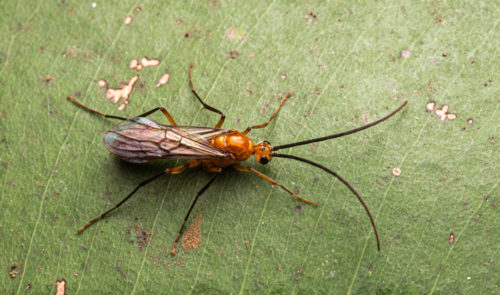
Curfew Capture 31. Alate Male drone.
This probably is male Diacamma ant species. Alate refers to a winged reproductive caste from a social insect colony in its winged form. Their common behavioural function is starting a new colony, to expand their mother colonies etc. I was intrigued why the antenna of this winged ant is not geniculate like that every other ant we see. After searching literature I found the following details.
The ant antennae are usually geniculate, with the first segment (the scape) elongate and the bend, or elbow, occurring between the distal end of the first segment and the second segment (the pedicel). The remainder of the antenna is termed the flagellum.

The antennae of male ant alates, bee drones and certain other infrequently seen hymenopterans are not geniculate. The antennae arise from the centre of the face and their bases are usually close together. These are thought of the primitive features which were retained from a common ancestor of Aprocrita suborder which makes up of ants wasps and bees.

Curfew Capture 32. Tropical Leatherleaf Slug (Laevicaulis alte)
As it started raining, Tropical Leatherleaf Slug (Laevicaulis alte) was seen at my house. It is a species of tropical land slug, a terrestrial pulmonate gastropod mollusc in the family Veronicellidae, the leatherleaf slugs. Laevicaulis alte is a round, dark-coloured slug with no shell, 7 or 8 cm long. Its skin is slightly tuberculated. The central keel is beige in colour. This slug has a unique, very narrow foot; juvenile specimens have a foot 1 mm wide and adult specimens have a foot that is only 4 or 5 mm wide.
This slug is an intermediate host for Angiostrongylus cantonensis, the rat lungworm, a roundworm, the most common cause of eosinophilic meningoencephalitis. This slug is eaten by the frogs like Hoplobatrachus tigerinus.
This species is probably indigenous to Africa but it has been introduced and become an invasive species in Asia & USA

Curfew Capture 33. Tiny ant mimic spider
Tiny ant mimic spider(Myrmyrachne sp.) feeding on a white fly. Whiteflies are Hemipterans that typically feed on the undersides of plant leaves family Aleyrodidae. whiteflies present major problems in crop protection. Worldwide economic losses are estimated at hundreds of millions of dollars annually. Spiders like Myrmyrachne are a great controller of these pests in your garden 🙂
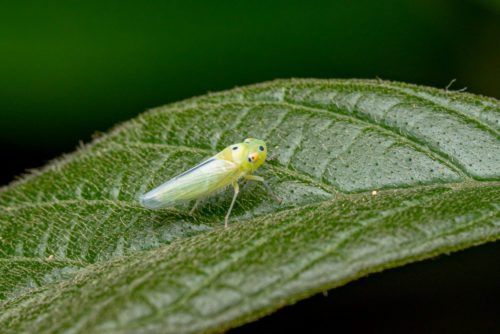
Curfew Capture 34. Leafhopper genus Kolla
Leafhopper genus Kolla Distant (Hemiptera: Cicadellidae: Cicadellinae) These minute insects, colloquially known as hoppers, are plant feeders that suck plant sap from grass, shrubs, or trees. Their hind legs are modified for jumping and are covered with hairs that facilitate the spreading of a secretion over their bodies that acts as a water repellent and carrier of pheromones. They undergo partial metamorphosis and have various host associations, varying from very generalized to very specific. Some species have a cosmopolitan distribution or occur throughout the temperate and tropical regions. Some are pests or vectors of plant viruses and phytoplasmas. The family is distributed all over the world, and constitutes the second-largest hemipteran family, with at least 20,000 described species.

Curfew Capture 35. Mud dauber of Sceliphron sp.
Sceliphron is a genus of Hymenoptera of the Sphecidae family of wasps, commonly referred to as mud daubers. They are solitary and build nests made of mud. Nests are frequently constructed in shaded niches, often just inside of windows or vent openings, and it may take a female-only a day to construct a cell requiring dozens of trips carrying mud. Females will add new cells one by one to the nest after each cell is provisioned. They provision these nests with spiders, such as crab spiders, orb-weaver spiders and jumping spiders in particular, as food for the developing larvae. Each mud cell contains one egg and is provided with several prey items. Females of some species lay a modest average of 15 eggs over their whole lifespan . Various parasites attack these nests, including several species of cuckoo wasps, primarily by sneaking into the nest while the resident mud dauber is out foraging.
I spotted this on this particular leaf on March 23rd. I was observing the same wasp on the same leaf every day since then, till today. It flies off for a short distance as I spot it and then returns to the same space. I did not see any mud nest nearby. Maybe it is waiting for the rains to start.

Curfew Capture 36. Hamataliwa spider juvenile.
Hamataliwa is a short-bodied drab-coloured Lynx spiders. Presents with a more or less ‘squat’ profile. The last pair of legs weakly developed. Arboreal. Found on tree bark. Twigs or on the leaves.

Curfew Capture 37. Thorn Mimic treehopper
These two are called Thorn Mimic treehopper as it looks like a thorn. This curious insect belongs to the group of treehoppers belonging to family Membracidae. Most treehoppers are considered as a pest, but some like Leptocentrus taurus was found feeding on the noxious weed Parthenium hysterophorus in Karnataka, India, thus acting as potential biological control agents.
Treehoppers, due to their unusual appearance, have long interested naturalists. They are best known for their enlarged and ornate pronotum, expanded into often fantastic shapes that enhance their camouflage or mimicry, often resembling plant thorns (thus the commonly used name of “thorn bugs” for a number of treehopper species). The specialised pronotum (or helmet) may not be simply an expansion of the prothoracic sclerite, but a fused pair of dorsal appendages of the first thoracic segment.

Curfew Capture 38. larval case of Psychidae moth
This is a larval case of Psychidae moth. The Psychidae (bagworm moths, also simply bagworms or bagmoths) are a family of the Lepidoptera (butterflies and moths). Most bagworms are inoffensive to humans and not at all conspicuous; some are occasional nuisance pests.
The caterpillar larvae of the Psychidae construct cases out of silk and environmental materials such as sand, soil, lichen, or plant materials. These cases are attached to rocks, trees or fences while resting or during their pupa stage, but are otherwise mobile. The larvae of some species eat lichen, while others prefer green leaves. Cases vary in their outward appearance – a mass of (mainly) plant detritus spun together with silk on the inside.

Curfew Capture 39. Gasteruptiidae wasp
This Gasteruptiidae wasp was resting on a blade of grass during the late evening. The Gasteruptiidae is one of the more distinctive families among the apocritan wasps, with surprisingly little variation in appearance for a group that contains around 500 species in two subfamilies (Gasteruptiinae and Hyptiogastrinae) and with 6 genera worldwide.
The propleura form an elongated “neck”, the petiole attaches very high on the propodeum, and the hind tibiae are swollen and club-like. This is a female as you can make out the long ovipositor with which she lay eggs in the nests of solitary bees and wasps, where their larvae prey upon the host eggs, larvae and provisions.
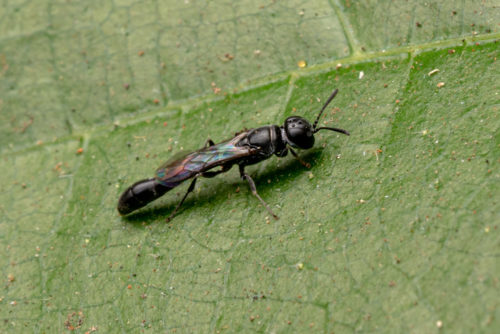
Curfew Capture 40. Trypoxylon wasp.
Trypoxylon is a genus of wasps in the family Crabronidae. All Trypoxylon species that have been studied so far are active hunters of spiders, which they paralyse with a venomous sting, to provide as food to their developing larvae. Depending on the species, they will either construct their own nest from mud or find cavities that already exist.[3] These cavities can range from keyholes to nail holes to previously abandoned nests, and are generally sealed with mud to create cells for their larvae.
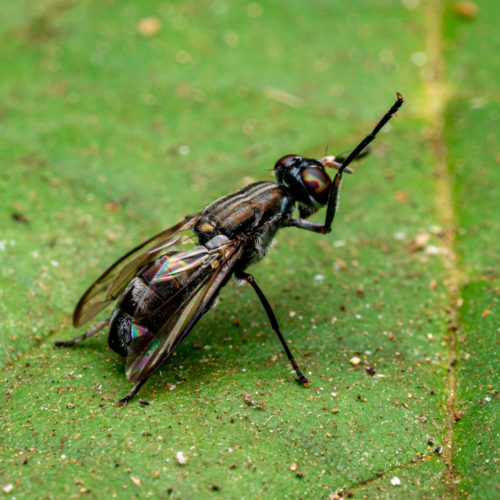
Curfew Capture 41. Signal Fly.
Platystomatidae (Signal flies) is a distinctive family of flies (Diptera). Their scientific name is derived from their flat mouth (platy = flat; stomato = mouth) Their common name, Signal flies, comes from their walking style, they exhibit a characteristic manner of movement, including rowing or extending of wings, waving of front pair of legs, move forwards and backwards, extend and raise of a proboscis. Signal flies are worldwide in distribution.

Signal flies are small, around 5-6mm in size with patterns on their wings and often on their faces and with metallic colours elsewhere. Adults have the typical vacuum cleaner mouthparts of a fly. In Signal flies, this protruding mouthparts resembles more of a gas mask. Adults are found on tree trunks and foliage and are attracted to flowers, decaying fruit, excrement, sweat, and decomposing snails. Larvae are found on fresh and in decaying vegetation, carrion, human corpses, and root nodules. Male Signal flies eat carbohydrates in the form of rotting fruit, nectar, and honeydew produced by aphids and leafhoppers. Females too eat the same stuff, but they also need protein from carrion (including dead insects), bird droppings or frass (insect poop) to support their reproductive activity.

Curfew Capture 42. Cuckoo Wasp
I found this dead mutilated Cuckoo Wasp on a leaf today. I am not sure how it died since it was beautiful even after death, I captured it.
Commonly known as cuckoo wasps or emerald wasps, the hymenopteran family Chrysididae is a very large cosmopolitan group of parasitoid or kleptoparasitic wasp. Cuckoo wasps pack a lot of drama into their tiny bodies. Their colour is part of the mystery. These wasps are parasites, and like their namesake cuckoo birds, they lay their eggs in the nests of other species (wasps or bees in this case). Since the cuckoo wasps depend on trickery and camouflage to fool their hosts, you might expect them to be drab. Scientists have not figured out whether the bright colours serve any function, and it wasn’t known until 2009 that the colour is actually produced by light refracting through open spaces between six layers of cuticle in the wasps’ exoskeletons.
They first find bees and wasps that are in the process of digging burrows and dragging paralyzed prey into their nests as food for their own young. Female cuckoo wasps then hide nearby to watch the burrow and either try to hitch a ride on the paralyzed prey as it’s being dragged into the burrow or else wait until the host flies off and then slip inside.
Despite their caution, cuckoo wasps are frequently caught in the act of sneaking in, but their oddly pitted exoskeletons protect them from the stings and bites of their hosts. The undersurface of the cuckoo wasp’s midsection is cupped so the wasp can tuck in its legs and curl into a tight ball (like a sowbug or armadillo) to protect its body. Host bees or wasps then have no other option but to grab the balled-up cuckoo wasp in their jaws and carry it outside the burrow to evict it. The unharmed cuckoo wasp simply turns around and tries to get into the burrow again.
Once the female cuckoo wasp succeeds in leaving its eggs in a burrow, the larvae have two survival strategies. Some larvae eat both the host’s larvae and its food items right away; others wait until the host larva eats its food supply and reaches full size, and then they eat the host larva. The first option requires the cuckoo wasp to eat several different kinds of food before it can pupate, while the second strategy lets the host larva do all the work, converting food stores into one juicy meal.

Curfew Capture 43. Ichneumon wasp.
The Ichneumonidae, is a parasitoid wasp family within the insect order Hymenoptera. This insect family, which so famously stirred sceptic thoughts in Charles Darwin, is among the most species-rich branches of the tree of life. The most commonly recognized wasps are boldly coloured social wasps whose females have venomous stings. They are in a separate clade: Aculeata. In contrast, ichneumonids have ovipositors instead of stingers, and they are all solitary. They use their ovipositors to lay eggs on or in the body of their prey, and the eggs hatch into carnivorous larvae that eat and kill the host.
The name is derived from Latin ‘ichneumon’,. The name first appeared in Aristotle’s “History of Animals”, c. 343 BC. Aristotle noted that the ichneumon preys upon spiders, is a wasp smaller than ordinary wasps, and carries its prey to a hole which they lay their larvae inside and that they seal the hole with mud. Aristotle’s writing, however, more accurately describes the mud daubers than the true ichneumon wasps, which do not construct mud nests and do not sting.
Adult ichneumonids superficially resemble other wasps. They have a slender waist, two pairs of wings, a pair of large compound eyes on the side of the head and three ocelli on top of the head. Their size varies considerably from a few millimetres to seven or more centimetres.
The ichneumonids have more antennal segments than typical, aculeate wasps (Aculeata: Vespoidea and Apoidea): ichneumonids typically possess 16 or more, while most other wasps have 13 or fewer. Unlike the aculeate wasps, which sting in defence and do not pass their eggs along with the stinger, ichneumonid females have an ovipositor (homologous to the stinger) which they use to lay eggs inside or on their host. Ichneumonids generally inject venom along with the egg, but only larger species (some in the genera Netelia and Ophion) with relatively short ovipositors use the ovipositor in defence. Males do not possess stingers or ovipositors in either lineage.

Curfew Capture 44. Breadfruit scale insect, Icerya aegyptiaca.
Icerya is a genus of scale insects in the family Monophlebidae. They infest leaves and produce large amounts of honeydew (clear, sugary excretions) that damage the fruit and foliage. Ants here are tending the Icerya for its honeydew.
Hosts are Breadfruit principally, but also avocado, banana, citrus, jackfruit, mango, soursop, taro, and many others, including ornamentals. Occasionally, the Icerya occurs on giant taro, pandanas, and young coconuts.
On breadfruit, the Icerya are found along the midribs and larger veins on the undersides of the leaves and also on the fruit. They suck the sap from the leaves, and heavy infestations cause the leaves to dry up and die.
Hermaphroditism is extremely rare in the insect world despite the comparatively common nature of this condition in the crustaceans. Several species of Icerya, including the pestiferous cottony-cushion scale, Icerya purchasi, are known to be hermaphrodites that reproduce by self-fertilising. There are only females: males are unknown. Females lay eggs (70 to 200, depending on temperature) into an egg sac (called an ovisac) that is attached to the tip of the abdomen. The eggs are oval, yellowish-orange. They hatch releasing orange nymphs or larvae; these are active and known as “crawlers”. They settle down after a day and become covered in wax.
There are two more moults producing the second and third larvae which are yellow to orange, covered in a white mealy substance mixed with wax, and have 21 white waxy processes, about 2.5 mm long, around their bodies. When adult, these white waxy processes are 3-4 mm long (Photo 1), the body is deep orange, oval, with black legs and antennae; the latter has 11 segments
The Icerya is spread by the crawlers moving to other leaves or by being blown in the wind to other plants. The honeydew and when this falls onto the leaves, sooty mould fungi grow on it, turning the leaves black and blocking photosynthesis.
Ladybugs are an important natural enemy of the Icerya, both at the larval stage as well as the adult. Predatory ladybeetles, Rodolia species, has been used in several counties to control the infestation.
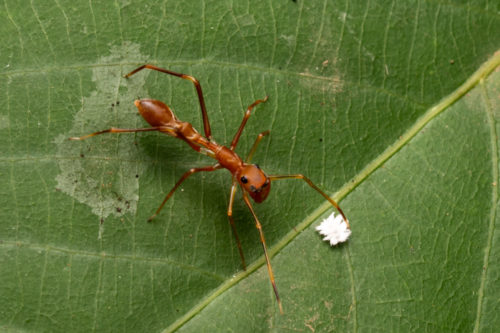
Curfew Capture 45. Myrmaplata plataleoides
Myrmaplata plataleoides(syn.: Myrmarachne plataleoides), also called the Kerengga ant-like jumper, is a jumping spider that mimics the Kerengga or weaver ant (Oecophylla smaragdina) in morphology and behaviour. This species is found in India, Sri Lanka, China and many parts of Southeast Asia.
Myrmaplata plataleoides, especially the females, mimic the Weaver Ants in size, shape and colour. The body of the M. plataleoides appears like an ant, which has three body segments and six legs, by having constrictions on the cephalothorax and abdomen. This creates the illusion of having a distinct head, thorax and gaster of the weaver ant, complete with a long and slender waist. The large compound eyes of the weaver ant are mimicked by two black patches on the head. The female’s front legs resemble the feelers of the Weaver Ants, while the males resemble a larger ant carrying a smaller one.
Myrmaplata plataleoides are sexually dimorphic. Female jumpers, measuring about 6–7 mm, are the best mimics of the weaver ants while the males which usually measure about 9–12 mm in length give the appearance of a weaver ant carrying a minor worker due to their elongated chelicerae which may be as long as one-third to half their body length. These elongated chelicerae are a secondary sexual characteristic of the males. The males use their long fangs like swords to fight off rivals. They can split their jaws, normally held closed, to unfold their fangs when required.

Curfew Capture 46. Berytidae
Berytidae is a family of the order Hemiptera (true bugs), commonly called stilt bugs or thread bugs.
The Berytidae are extremely gracile insects with legs so long and slender as to suggest common names such as “thread bugs” and “stilt bugs”. In this, they resemble the Emesinae, with which they are easily confused, though they are in different families. They may be distinguished most readily by the forelegs, that in the Emesinae are raptorial in a way resembling those of the Mantodea, Mantispidae and certain other invertebrate predators.

In form and function, the forelegs of the Berytidae are roughly similar to those of their other legs. Other differences are subtler and not fully consistent. For one thing, the antennae of most Berytidae though long, geniculate, and in other ways generally similar to Emesinae, tend to have a more or less obvious swelling at the tip. Some members of the family also have slight swellings at the distal ends of the femora of their legs, though in many species this either absent or not obvious.
They are sap-suckers like most other Hemiptera, but some also feed on mites and small insects.

Curfew Capture 47. Assassin bugs
Assassin bugs are members of the Reduviidae family, and true to their name, these tiny ninja warriors prey on the enemies of precious plants. This one is a Larger assassin bug nymph nearby.
Beneficial insects are crucial to healthy gardens. The assassin bug is one such helpful insect. Recognizing this garden predator as a good garden helper rather than a potentially scary threat to you puts a natural perspective on the normal cycle of life in your landscape. Assassin bug identification will also prevent some nasty and very painful bites that may occur accidentally.
Assassin bugs occur in much of North America but also Central and South America, Europe, Africa and Asia. There are several species of the insect, all of which are natural ambush hunters that inject a toxin into prey which dissolves their soft tissues. These bites are fatal to their insect victims but may also cause allergic reactions in humans, resulting in painful itching and burning at the injection site.

Assassin bugs have several stages of life. Assassin bug eggs may be found in cracks, under rocks and in other sheltered locations. The tiny clusters of eggs hatch to become assassin bug nymphs, which are the larvae of the insect. Assassin bug nymphs are less than ½ inch long and are orange and black striped with an almost translucent base colour.
The adult form of the insect may grow up to an inch in length. These have a 3-part body consisting of a head, thorax and abdomen. The head is cone-shaped and sports a curved beak from which the insect injects its toxin. They also bear long antennae and six long legs. Assassin bug identification also notes that the insect is beige with black markings and folded wings perched on its back.

Assassin bugs inject a poison into their prey through their beak. This proboscis-like appendage delivers toxin into the vascular system and causes almost instant immobilization and simultaneous liquefaction of internal fluids. These fluids are sucked out of the prey. The prey is left behind as just a husk.
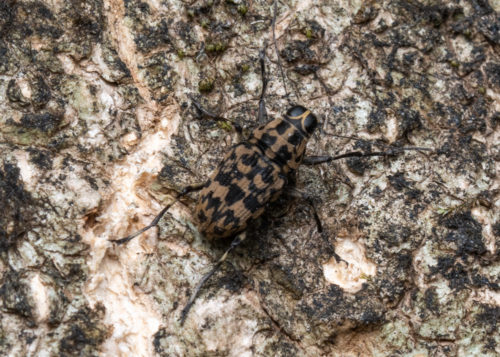
Curfew Capture 48. Fungus weevil (Anthribidae family)
Anthribidae is a family of beetles also known as fungus weevils. The antennae are not elbowed, may occasionally be longer than the body and thread-like, and can be the longest of any members of Curculionoidea. As in the Nemonychidae, the labrum appears as a separate segment to the clypeus, and the maxillary palps are long and projecting.

Most anthribids feed upon fungi or decaying plant matter, and the larvae feed within deadwood. Some species of Choraginae feed upon seeds, while unusually, Anthribus feeds upon soft scales.

Curfew Capture 49. Carrhotus spider.
Carrhotus is a genus of jumping spiders. Carrhotus species tend to be found in silken cells in low vegetation in the open. They are not very colourful and are sturdy, solid-looking spiders.
Carrhotus is a very widespread genus of dull coloured salticids. The cephalothorax is quite high with the top slightly convex, with the rear of the thorax and the sides very steep. In the plan, the carapace is U-shaped with the rear margin fairly widely truncated. The abdomen is oval, tapering somewhat towards the rear. The legs are longish, slender and all about the same length.

Curfew Capture 50. Halys species (Hemiptera: Pentatomidae).
As I started collecting photos of critters in my home garden since 22nd march 2020, I was astonished to find the number of insects both beneficial and harmful living in harmony. My aim was to get at least 50 species before the Lockdown ends on April 14th, yesterday. (it is now extended any way). I got nearly 70 plus species till now.
I found this stink bug on the bark of Indian almond (Terminalia catappa) tree where it was sitting camouflaged. Every day since the Lockdown occurred I was watching it, it never moved away from that one single spot. Even today I spot it staying and sucking the sap in the same location. While we humans get agitated by the lockdown and want to get away, but this bug was happy where it was.
On 30th March I noticed it had a company of another of its species. I was hoping they will mate, Since none moved for very long I left without disturbing them. Next day it was all alone again.

The name “Pentatomidae” is from the Greek pente meaning “five” and tomos meaning “section”, and refers to the five segments of their antennae. Pentatomids are generally called “shield bugs” in English, or “stink bugs” in American English. However, the term shield bugs is also applied broadly to include several related families (e.g. Acanthosomatidae, Scutelleridae, and Cydnidae), or specifically only to refer to species in the family Acanthosomatidae. The term shield bug refers to the generalized body shape of adult bugs in these families which resembles a heraldic shield when viewed from above.
The American name “stink bug” is specific to the Pentatomidae, and refers to their ability to release a pungent defensive spray when threatened, disturbed, or crushed. The composition of this spray may vary between species, and even by sex or age, but generally includes aldehydes and alkanes. Descriptions of the smells vary widely, and include oily, dusty, woody and earthy, and like coriander. In some species, the liquid contains cyanide compounds and a rancid almond scent, used to protect themselves and discourage predators.
Several stink bugs and shield bugs are considered agricultural pests, because they can grow into large populations that feed on crops, damaging production, and they are resistant to many pesticides. They are a threat to cotton, corn, sorghum, soybeans, native and ornamental trees, shrubs, vines, weeds, and many cultivated crops.
Some are commonly eaten in Laos and are regarded as delicious due to their extremely strong odour. The insects are sometimes pounded together with spices and seasoning to prepare cheo, a paste mixed with chillies and herbs.


Amazing work Doc! Its it sad that we have become ignorant of nature’s harmony and abundance around us while running a rat race of a meaningless, shallow life. Couldn’t imgine that we are surrounded with so many insects in our backyard. Thanx for sharing ?
Wonderful work done NY you Doctor
Hats of to your efforts. Personally not seen many of these or not noticed these creatures.
However lete make a mention that duromf the lockdown period while I was in my encestral home with my brother and his family
That was the time I spent withy camera peruing my hobbynof capturing birds. Ultimately noticed had captured about 40 species of birds in the village. And total count of clicks crossing about 20k. During those 42 days between 6.45am to 9.00am and on ocassions between 5.15pm to 6.45pm. Was time well spent. Never expected such success
Not feeling sorry for not having a DSLR
Thank you so much. Lock down was an opportunity for me to explore my surrounding more deeply. Your bird captures are really nice as I am watching in our FB group. Such a time away from our busy schedule really helps us to concentrate on what we were missing all along 🙂
I like the pictures you’ve taken during “LOCKDOWN”!Especially picture number 45(Myrmaplata plataleoides).I knew that they were real, I just believed that they were ants and not spiders!Thank you; Dr. Krishna Mohan.
They are great ant mimics. definitely tough to differentiate them from real ants